Brief

In the 2014 Bain Brief “Teaching Dinosaurs to Dance,” our first report on the conglomerates of Southeast Asia, we presented the surprising findings from our research: Although commonly viewed as dinosaurs that had outlived their prime, conglomerates actually were thriving in Southeast Asia. They were outperforming their counterparts in developed markets and consistently delivering higher shareholder value than companies in the region that focused on a single business. Since then, the business climate has become more challenging, with the global slowdown in GDP growth, heightened concern about China’s economic restructuring, slumping commodity prices and increased political risk in Southeast Asia and beyond.
Given these strong headwinds, we decided to take another look at conglomerates to assess the impact of these changes and determine whether conglomerates can still outperform their pure-play rivals. We expanded our sample set to include more conglomerates—both emerging challengers as well as large family groups. (We assessed 53 publicly listed conglomerates and 14 private conglomerates by evaluating multiple listed subsidiaries.) In total, we analyzed the performance of 67 large family- and government-linked conglomerates in Indonesia, Malaysia, the Philippines, Singapore, Thailand and Vietnam over a 10-year period (2006 to 2015).
We found that conglomerates continue to play a major role in Southeast Asia, accounting for around 40% of the top listed stocks. Although creating value has become much more difficult in the region, conglomerates continue to outperform their focused peers as they did from 2003 to 2012, albeit by a noticeably reduced margin (see Figure 1). Median total shareholder return (TSR) has fallen, from an impressive annual 29% from 2003 to 2012 to a still-respectable 13% from 2006 to 2015. (TSR is defined as stock price changes, assuming reinvestment of cash dividends.) Similarly, pure plays saw median TSR decline in the same periods, from 19% to 11%.
Conglomerates still can make great strides in Southeast Asia. In fact, during the same period, those in the top quartile achieved a median annual TSR of 25%—much higher than the 3% for the bottom quartile. To our surprise, the top 10 have proven to be highly diverse, spanning different sizes, countries and industries.
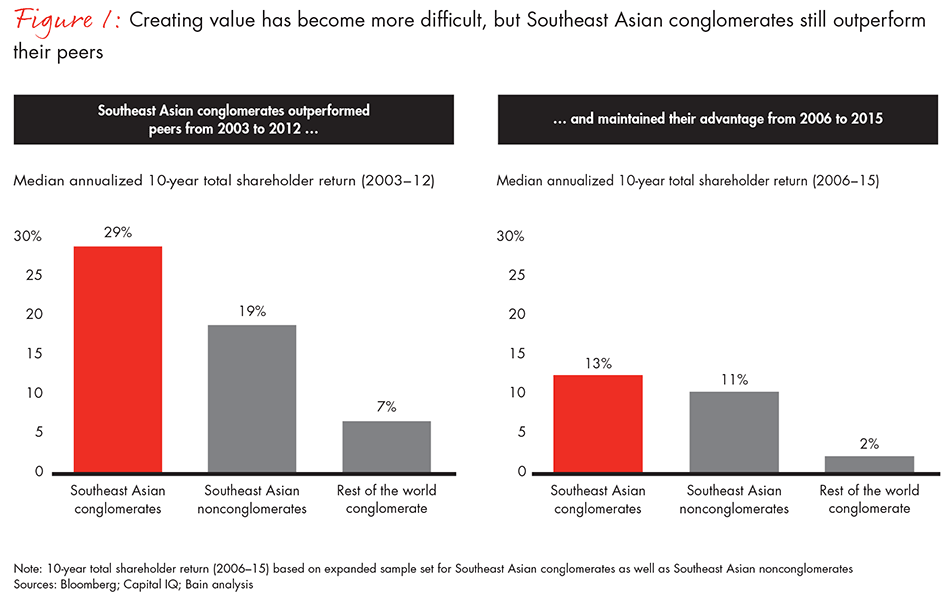
But the factor that helped many conglomerates in the years prior to 2012 is the same element that hurts them now: heavy exposure to commodities. As many as 30% of the region’s conglomerates have a commodity focus. During the commodities boom years, conglomerates benefited from rising prices in agriculture, livestock and natural resources. But their fates reversed with the recent softening of prices for many commodities.
Maintaining a competitive edge
Clearly Southeast Asia’s conglomerates are facing a more challenging market environment. When the region’s economies were in earlier stages of development, many companies benefited from the rising tide of rapidly growing incomes. Conglomerates enjoyed multiple advantages over their focused peers: They had greater access to capital, strong government relations, and their pick of talent because of prestige and perceived job stability. As economic growth slowed across Southeast Asia (for both cyclical and structural reasons) and the market became more competitive, these traditional advantages began to erode. Although some conglomerates have been agile and forward-thinking enough to adapt and remain competitive, others have not been as fortunate.
Jean-Pierre Felenbok, a partner with Bain’s Strategy practice, highlights five things conglomerates can do to keep their competitive edge.
We have five recommendations for any conglomerate hoping to live long and prosper amid the uncertain economic environment and rising competition.
1. Enhance portfolio resilience. Our research shows that conglomerates with portfolios heavily weighted toward commodities suffered from 2012 to 2015, faring worse than the region’s pure plays. In the decades when they benefited greatly from their commodities exposure, they had little incentive to prepare for the bear market by moving into less volatile, but related, downstream businesses or by diversifying portfolios. Consequently, many have struggled.
We believe that, despite their volatility, many commodities remain fundamentally attractive over the long term. Yet, given the current low prices and unclear midterm outlook, commodity-focused companies need to reconsider the fundamental makeup of their portfolio and how to better handle that volatility and uncertainty.
A first key step is to filter uncertainties by focusing on what really matters. Modeling “future-back” scenarios enables conglomerates to develop a robust strategy at both the group and business-unit levels. Having a portfolio of bets and options allows for agility and prioritization in a time of turbulence.
This is the successful approach of Olam International. With commodities serving as the foundation of its business, the Singapore-based agribusiness company is exposed to major volatility and uncertainty. Yet it put in place a disciplined system to identify and manage these risks.
Consider how Olam rigorously analyzed the risks in the almond business before making one of its biggest acquisitions in 2009—the A$288 million purchase of 50% of Australia’s almond-growing area. Olam assessed macro trends to pinpoint the sources of risk. For example, it knew that demand would grow slowly, but predictably. However, supply-side trends were less predictable. The key test was that, with its scale and cost efficiency, Olam’s almond business would remain profitable even during the darkest hours of the commodity slump, when almond prices hit an all-time low. It worked. Olam has now established itself as the world’s No. 2 almond grower.
2. Rethink the ownership model and capital structure. With the rapid evolution of financial markets, conglomerates need to reconsider which of three ownership models best positions them for future growth:
- Privately held holding company with listed and unlisted subsidiaries
- Listed holding company with some subsidiaries also listed
- Divisional structure with a listed holding company and all business units private and fully owned
There is no one optimal model. The choice comes down to the trade-off between capital and control. Capital considerations include obtaining access to external capital, maximizing valuations, segregating risks and advancing toward professionalization. Control considerations include retaining decision-making authority, allocating resources (both capital and people) flexibly, capturing group synergies across business units and keeping the structure simple.
The rapid evolution of financial markets is prompting Southeast Asian companies to rethink their capital structure. Investors have become more critical of groups with multiple, interlocking listings, penalizing such groups with hefty “conglomerate discounts.” Meanwhile, privatizations are on the rise as companies face the costs and downside of public market listings.
Also, companies have a much wider array of choices for raising capital. Some turn to new hybrid models, such as structured debt and profit-participating schemes. Others find new sources of capital—everything from private equity to sovereign wealth funds to strategic investors, especially from Japan.
Given these trends, many conglomerates are considering moving toward one of two end states. Keeping the holding company private while listing some of the business units makes sense where business units are highly diversified and the conglomerate values access to external markets and risk segregation. Alternatively, adopting the divisional model might be more appropriate when there is high value added from the group as well as major benefits from managing capital and people resources freely across the group.
F&N in Singapore, which was a highly diversified conglomerate listed at both the group and business-unit levels, has substantially simplified and realigned its capital structure over the past five years. Under its new owner, the Thai TCC Group, F&N became two distinct business units: F&N, the consumer-products company focusing on food and beverage and publishing, and Frasers Centrepoint, focusing on property. The market has rewarded the F&N capital simplification under TCC. The group’s blended enterprise value divided by earnings before interest, taxes, depreciation and amortization (EV/EBITDA) multiple increased from 18 in 2011 to 20 in 2015.
3. Find new sources of profitable growth through mergers and acquisitions (M&A), international expansion and digital muscles. Outside of the Philippines and Vietnam, top companies across Southeast Asia saw negative revenue growth from 2011 to 2015, driven in part by intensified competition (see Figure 2). Finding new sources of growth is therefore a top priority.
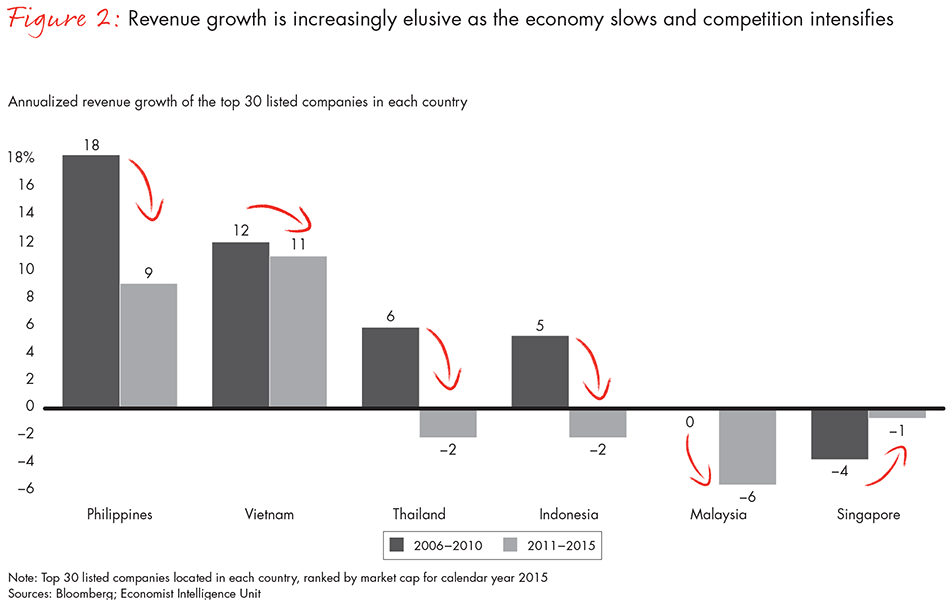
M&A. More conglomerates are pursuing M&A to fulfill growth ambitions that are more difficult to achieve organically. In our experience, M&A is an acquired skill and frequent acquirers substantially outperform infrequent acquirers. Based on Bain & Company research, conglomerates in Southeast Asia that executed 10 or more deals (acquisitions and divestments) achieved a median TSR of 13% in the 2011 to 2015 period, while non-acquirers achieved only 2%.
Central Group, Thailand’s leading retail group, has repeatedly used M&A. The conglomerate’s revenue increased 19% annually from 2011 to 2015. M&A enabled Central Group to build new capabilities, such as an e-retail channel, through its 2016 acquisition of Zalora, an e-tailer in Thailand and Vietnam. It also used M&A to establish leadership positions in core growth markets, building scale in Vietnam by acquiring hypermarket chain Big C and electronics retailer Nguyen Kim. M&A also has helped Central Group establish a foothold in new markets—it entered the premium department store market in key European tourist destinations by acquiring La Rinascente in Milan and Illum in Copenhagen.
The best acquirers take an integrated approach to managing the M&A cycle, from making M&A a crucial part of their growth strategy, to creating a strong deal thesis, to performing very rigorous diligence and valuation, to employing disciplined merger-integration planning and execution. Arguably, conglomerates have an advantage over pure plays because they can draw on their M&A experience across their business units.
Internationalization. Except in Singapore, conglomerates in Southeast Asia derive most of their earnings from their home country. That is especially true in Indonesia, Malaysia, the Philippines and Vietnam.
The common market created by the ASEAN Economic Community (AEC) is expected to accelerate the pace of internationalization, tempting conglomerates to look overseas when domestic economic growth slows. But internationalization comes with pitfalls. In our experience, the most important reasons for failure are choosing the wrong geographic markets, entering markets that overlap little with the domestic business, and neglecting the need to achieve a leadership position in existing and new markets (see Figure 3). Poor strategic choices are often compounded by weak execution, as companies often set unachievable targets but exit too quickly when facing early setbacks.
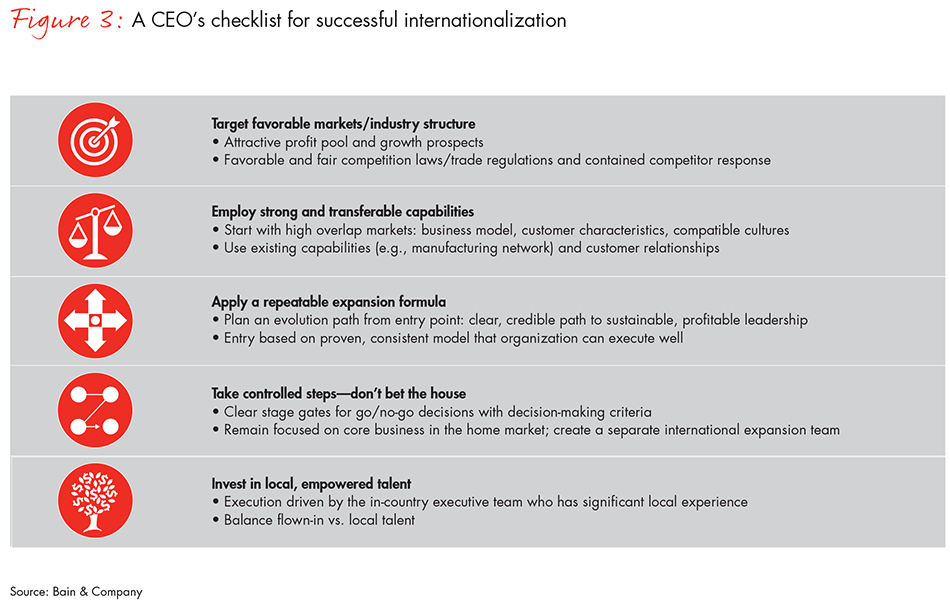
Based on Bain & Company analysis, conglomerates perform best if they commit to international expansion or double down on their domestic market. Conglomerates that focused on overseas expansion achieved a median TSR of 9% from 2011 to 2015, while those that increased their share of domestic revenue achieved a median TSR of 13%. However, conglomerates that tried to do a bit of both only achieved a median TSR of 3%.
If a company has a large and fast-growing domestic market, the best course of action may be to remain local and increase its bets on domestic opportunities. That was the decision of Ayala in the Philippines. The conglomerate looked inward for growth as the home market expanded. It established new business units that take advantage of strong macro trends in the nation, including utilities and transport to plug the Philippines’ infrastructure gap, automobiles to meet the growing middle class’s demand for vehicles, and education and health programs to address the lack of high-quality, affordable basic social infrastructure. These new domestic business units have contributed significantly to Ayala’s growth. For example, automobile revenues grew 20% annually from 2011 to 2015.
But a domestic focus may not be the best option for conglomerates with small and maturing home markets. To glimpse the potential of internationalization as a growth strategy, look at the experience of Charoen Pokphand Group, one of Thailand’s largest conglomerates. CP’s international revenues grew 23% annually in the 2011 to 2015 period, compared with 15% growth in Thailand.
The group’s core business unit, CP Foods, operates across the agri-food business chain, from farming to feed manufacturing and distribution to food processing. CP Foods now derives around 67% of its revenues internationally, compared with 39% in 2011. To succeed overseas, CP Foods prioritized large markets with strong growth: China, Indonesia and Vietnam. It relentlessly built scale so that it is now No. 1 in its sector in Indonesia and Vietnam, and is a top-four player in China.
Digital. With digital disruption upending industries, conglomerates face a severe challenge. Smaller, nimbler companies are faster and more proactive in taking advantage of opportunities, whereas conglomerates’ scale and complexity may hamper their ability to respond. In fact, conglomerates’ advantages—such as their access to capital and strong leadership positions—may breed complacency and dampen their thrust to innovate. This is especially true at many Southeast Asian conglomerates, which remain industrial and commodity-focused, with core businesses that have been relatively protected from disruption thus far.
However, conglomerates can still act to ensure that they disrupt instead of being disrupted. They can start by asking fundamental questions: What is the pace of change (in terms of customer acceptance, investment level and regulatory support)? And what is the impact on each of our businesses? They can encourage each of their businesses to develop its own digital strategy and avoid center-led efforts, given the need for speed.
Southeast Asia’s conglomerates can learn digital innovation from multinationals such as GE and Procter & Gamble (P&G). Both companies have taken different approaches to digitally transform their core businesses. GE has redefined its strategy in response to digital disruption. It believes that the Internet of Things—or “industrial Internet”—is a major disruption that presents a huge opportunity for industrial companies. Hence, GE now aims to become a leading software company, creating an operating system that enables its existing industrial hardware. In contrast, P&G has retained its strategic focus, but sees digital technology as a means of achieving operational excellence.
GE and P&G have also taken different approaches to digital transformation. GE created an independent digital business unit, while P&G chose to embed digital across its value chain.
GE charged its newly formed digital business with creating the company’s new operating system. It hired top talent from the technology industry and moved its headquarters from Connecticut to Boston to take advantage of the city’s deep pool of software talent. Just one year into launch, this digital unit is already a $5 billion business.
For its part, P&G focused on building digital capabilities across its value chain to encourage bottom-up innovation. For example, in marketing, the introduction of real-time brand-perception tracking has reduced costs by $900 million since 2003. Across its supply chain, real-time fleet tracking delivered a 15% increase in efficiency.
GE and P&G illustrate how incumbents can tackle digital transformation with a range of options. What matters is having the will to do so, and building the requisite digital muscles.
4. Tackle costs and improve productivity to remain competitive and expand margins. Even as globalization boosts competition and revenue growth stalls, costs continue to rise. Unfortunately, Southeast Asia’s conglomerates have been slower than their focused counterparts to tackle the mounting cost and productivity challenges. From 2011 to 2015, the region’s conglomerates saw a 2% median annual increase in revenue, but operating expenses rose by 3%. Median operating expenses as a percentage of revenues increased from 13% in 2011 to 15% in 2015. By contrast, the region’s pure plays have kept median operating expenses at 15% of revenues.
Our research determined that the conglomerates that tackled cost and productivity head-on have achieved superior TSR. Only about 30% of Southeast Asia’s conglomerates reduced operating expenses as a percentage of revenue from 2011 to 2015. But those cost improvers achieved a median five-year TSR of 6%, compared with 3% for cost underperformers.
A conglomerate’s size and complexity create ways to hide costs, cross-subsidize businesses and avoid tough decisions. Meanwhile, the additional cost of group management exerts a higher toll in tough times than in good times.
Few conglomerates have used the downturn to critically reevaluate the added value and costs of the center. Only 16% of conglomerates reduced selling, general and administrative (SG&A) costs as a percentage of revenues from 2011 to 2015, compared with 50% whose SG&A increased as a percentage of revenues. But our analysis shows that those that became leaner delivered a median five-year TSR of 8% in the same period, compared with 3% for cost laggards (see Figure 4).
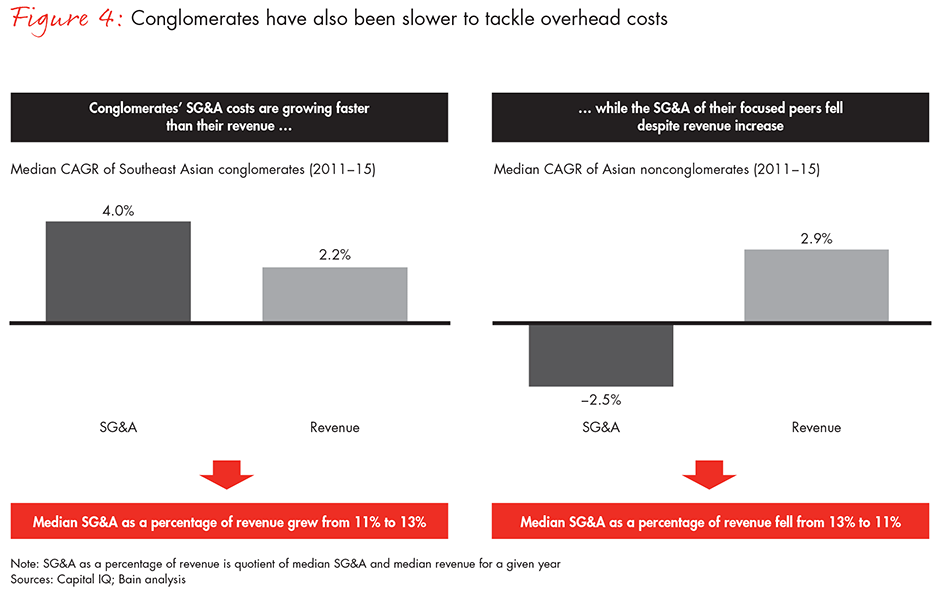
5. Rediscover the Founder’s Mentality®. Slower growth and declining profitability, threats from digital disruption, struggles to win the war on talent—are some of the region’s conglomerates finally facing the prospect of extinction, the fate of many conglomerates in other parts of the world? Amid the current turmoil, Southeast Asia’s conglomerates can perhaps gain new life by taking the advice of our colleagues Chris Zook and James Allen, authors of the new book The Founder’s Mentality: How to Overcome the Predictable Crises of Growth.
In their book, Zook and Allen explain how great and growing companies survive the existential crisis of growth by reinvigorating the fundamental values that made them great in the first place. They call this the Founder’s Mentality: the sense of purpose and mission that created the business, an obsession with the customer and the front line, and an owner’s mindset.
To rediscover their Founder’s Mentality, conglomerates should focus on three priorities:
- Refresh the bold mission. Insurgents typically have a clear answer to the question, “Why do we exist?” But as conglomerates grow, clarity becomes more difficult to find. To rediscover the spirit of insurgency, conglomerates need to define their unique purpose for being in business in a manner that resonates across their portfolio and energizes their employees.
- Accelerate decision making. With scale often comes complexity, which is the silent killer of growth. It is easy for conglomerates to create layers of bureaucracy, resulting in a siloed, risk-averse organization with paralyzed decision making. To create speed, conglomerates need to cut complexity and redeploy trapped resources.
- Create a compelling talent value proposition. In an environment where the talent gap is the biggest internal barrier to growth, conglomerates risk losing talent to nimbler, more appealing challengers. To revitalize their resources, conglomerates should consider revamping their talent-management programs. For example, rotating managers across business units could provide top performers with opportunities to stretch, while creating a class of top talent that can readily fill mission-critical positions anywhere in the group.
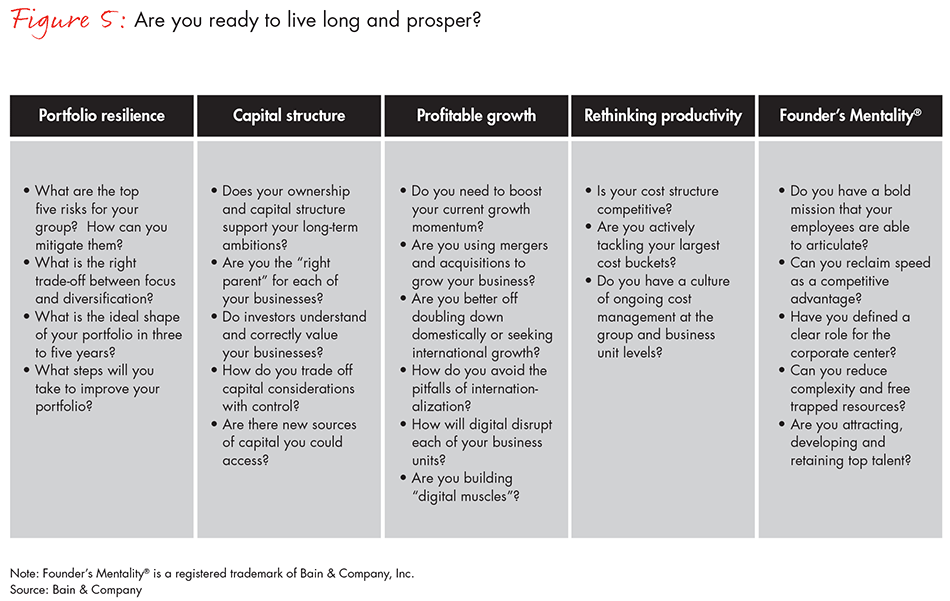
The road ahead
Turbulence and uncertainty are here to stay. Conglomerates must become fitter, faster and—most likely—slimmer versions of themselves. Only then can they live long and prosper.
- Reduce the number of businesses they participate in and focus on where they can have attractive leadership positions;
- Review their capital structure and ownership model to optimize the trade-offs between access to capital and ability to control;
- Invest in new sources of growth, through M&A, internationalization or digital disruption;
- Improve productivity and efficiency at both the business unit and group levels; and
- Reinvigorate what made their companies great in the first place: Rediscover a bold mission, accelerate decision making and focus on talent.
Till Vestring is a partner in Bain & Company’s Singapore office. Jean-Pierre Felenbok is a Bain partner who leads the firm’s Jakarta office.
The authors would like to acknowledge the support provided by Gerald Tan, manager, and Lee Xueling, senior consultant, in Bain’s Southeast Asia practice and by David Diamond, Bain’s editor for Asia-Pacific.
Founder’s Mentality® is a registered trademark of Bain & Company, Inc. Repeatable Models® is a trademark of Bain & Company, Inc.




